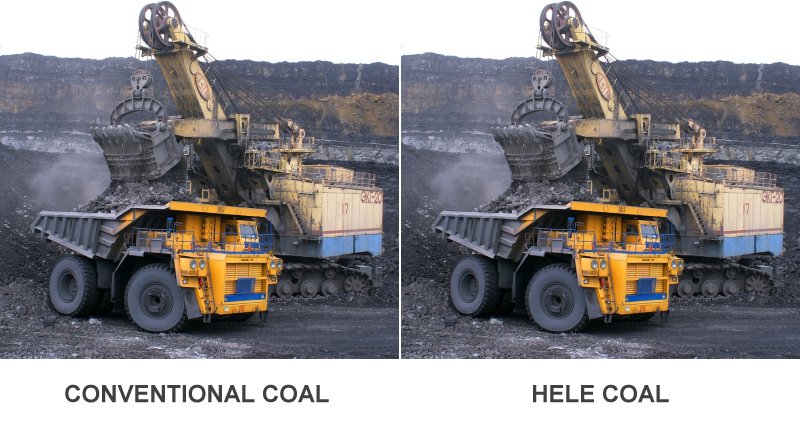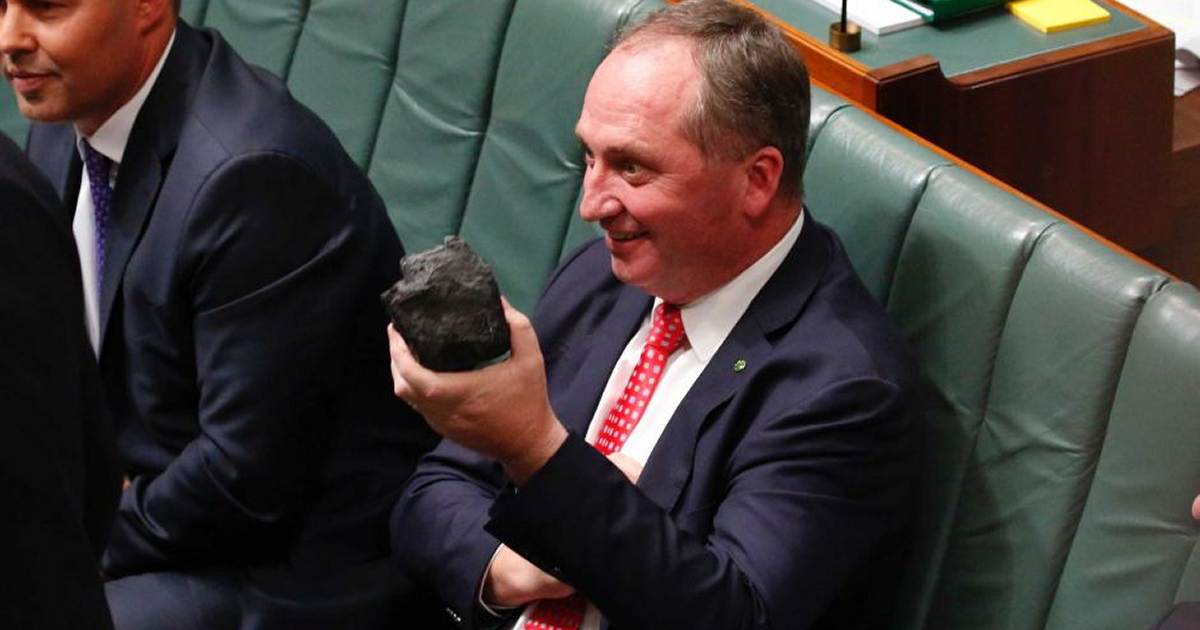During a House of Representatives debate yesterday on proposed changes to how the Clean Energy Finance Corporation (CEFC) can invest, Barnaby Joyce stated his case for coal power to be included.
Being debated was the Clean Energy Finance Corporation Amendment (Grid Reliability Fund) Bill 2020. It would amend the Clean Energy Finance Corporation Act 2012 to establish the $1 billion Grid Reliability Fund. The Fund will support investments in new energy generation, storage and transmission infrastructure, including eligible projects shortlisted under the controversial Underwriting New Generation Investments (UNGI) program.
Part of UNGI’s controversial nature is that includes gas projects – but Barnaby Joyce wants the CEFC to be able to go even further into supporting fossil fuels.
“I will be moving an amendment for high-intensity low-emission coal-fired power,” stated Mr. Joyce.
By “high intensity”, which he mentioned three times, it’s assumed he meant “high efficiency”.
About HELE Coal
High Efficiency Low Emission (HELE) coal power is a rather misleading term.
The Finkel Review report from a few years back noted the following estimated operating emissions (kg CO2-e/ MWh) for various types of coal power:
- Subcritical (conventional) brown coal – 1,140
- Supercritical brown coal (HELE) – 960
- Subcritical (conventional) black coal – 940
- Supercritical black coal (HELE) – 860
- Ultra-supercritical brown coal (HELE) – 845
- Ultra-supercritical black coal (HELE) – 700
Lower emissions, yes – low emissions – certainly not.
Added to that are the various toxins spewed into the atmosphere by burning the stuff, HELE or non-HELE, and the millions of tonnes of coal ash (also toxic) created as a waste product. Carbon and toxic emissions and waste aside, the following shows the differences between conventional and HELE coal in terms sourcing the problematic black rock.

Meet the new coal, same as the old coal.
HELE coal power is also more expensive than renewables. As recently mentioned after Senator Matt Canavan’s push for more coal and gas power, CSIRO’s GenCost report released in December showed wind and solar power continue to be the cheapest source of energy in Australia. This remains the case even when taking into account additional system integration costs such as energy storage and added transmission expenditure.
Just Because Your Peers Do It…
Barnaby Joyce mentions other countries are still using coal for power generation, and on that basis, so should we – and to show them how it’s done. Aside from the fact that for the most part the world *is* transitioning away from coal power, I think many of us when growing up were counselled by our parents that just because our peers are doing something stupid, it doesn’t mean we should too. It was pretty solid advice I wish I heeded more often.
Barnaby’s speech contained a number of inaccuracies and non sequiturs – for example mentions of blackouts that had nothing to do with a lack of electricity generation. He also refers to high electricity prices, but fails to mention the downwards pressure on wholesale electricity prices thank to renewables.
But a very valid point Mr. Joyce made was:
“If we keep driving this agenda where we can’t even discuss high-intensity low-emission coal-fired power but in the same breath out of the other side of your mouth say, ‘But I believe in the coal industry’, it looks like complete and utter hypocrisy. It looks like you’re completely and utterly dodgy, and you’re not philosophically correct. You can’t say you support the coal industry but you don’t support the usage of coal.”
He’s spot on there. But the only support the coal industry needs is transitioning away from it.


 RSS - Posts
RSS - Posts



We don’t need net emissions to be reduced by 25%. We need them to be reduced 100%. That square peg does not fit into that round hole.
If Barnaby Joyce whittles the peg further by adding carbon capture and sequestration it might technically fit in the round hole, but it would be a hell of a lot easier to just use a round peg in the first place.
(And before anyone points it out, plans for carbon capture at coal power stations — which will never be used — generally only involve capturing a portion of emissions.)
Hear hear, well said!!
I’m curious though, anything high efficiency generally means it’s a more expensive product to achieve the high efficiency results.
So, will HELE be more expensive? If so, that means it will drive up wholesale prices. But hang on, isn’t renewables cheaper and cleaner??? Then it’s pointless even thinking about HELE.
Yep. Given the low cost of coal in Australia building HELE plants will increase the cost. They can also have reliability issues, although I have heard Chinese engineering has mostly overcome them.
https://reneweconomy.com.au/newest-coal-generators-rank-amongst-australias-worst-for-reliability-37103/
As China has the affordable engineering talent when it comes to this type of coal power, Barnaby Joyce’s desire for HELE coal power would likely result in billion dollar construction contracts with Chinese companies.
Graham,
You ask: “So, will HELE be more expensive?”
Short answer: Yep.
Longer answer:
HELE units require more advanced, higher performance materials in the boilers, high pressure steam pipes, valves and high pressure turbines, because the operating steam temperatures and pressures are higher than in subcritical power plants, and therefore cost significantly more to build.
Subcritical units operate below 550 °C, coal consumption is typically more than 380 g/kWh, CO2 intensity is at or greater than 880 g CO2/kWh, and high heating value (HHV) based operating efficiencies up to 35%.
Supercritical (SC) units operate at between 550–600 °C, coal consumption is typically around 340–380 g/kWh, CO2 intensity is around 800–880 g CO2/kWh, and HHV operating efficiencies up to 39%.
Ultra-supercritical (USC) units operate above 600 °C, coal consumption is typically around 320–340 g/kWh, CO2 intensity is around 740–800 g CO2/kWh, and HHV operating efficiencies up to 42%.
Advanced USC (A-USC) units operate up to 700 °C, coal consumption is typically around 290–320 g/kWh, CO2 intensity is around 670–740 g CO2/kWh, and HHV operating efficiencies up to 47%.
“… a strong carbon price signal will be needed with strict emission standards to enable HELE transition.”
https://www.mdpi.com/2071-1050/13/3/1591/pdf
I suspect the coal consumption, CO2 intensity and efficiencies listed above are for units using premium low ash, low sulphur, higher (6,100+) kcal/kg content coal.
Brown coal (lignite): 2,200-4,600 kcal/kg
Sub-bituminous coal: 4,700-7,200 kcal/kg
Bituminous coal: 6,100-8,300 kcal/kg
Anthracite: 7,200-8,300 kcal/kg
Highest efficiencies are achieved at constant load (i.e. ‘baseload’) and high utilization capacities (80+%) output. Ramping output up and down to match variable demand and with reduced utilization rates significantly lowers unit efficiencies and increases operating fuel consumptions and emissions.
I don’t think Barnaby Joyce (or the Nationals) would be supporting a strong carbon price.
And the latest CSIRO/AEMO GenCost report (and also referred in Michael Bloch’s post above):
“…shows wind and solar continue to deliver the cheapest sources of new electricity generation capacity – with each maintaining that ranking in 2030 even when new transmission network infrastructure and energy storage are taken into account.”
“In virtually all scenarios, the combined costs of renewables, storage and networks would still come in cheaper than new build gas or coal generation.”
https://reneweconomy.com.au/wind-solar-and-storage-still-cheapest-by-far-latest-csiro-gencost-report-says-34929/
Indeed, based on the compelling evidence I see, it’s now pointless even thinking about new HELE (or gas).
Meanwhile, published in the AFR on Tuesday (Feb 16) afternoon, was an article by Angela Macdonald-Smith headlined “Coal power stations going broke: Schott”, beginning with:
“Coal power stations are on track to close four or five years before the end of their rated life as plentiful renewable energy coming online makes them unprofitable, according to energy policy tsar Kerry Schott.”
See: https://www.afr.com/companies/energy/coal-power-stations-going-broke-schott-20210216-p572xn
AGL’s Liddell Power Station in NSW is due to close in Apr 2023.
A five-year acceleration of other Australian major coal plant closures could see:
* Delta’s Vales Point Power Station closing as early as in 2024;
* EnergyAustralia’s Yallourn and Origin Energy’s huge Eraring plant closing as early as in 2027; and
* AGL’s large Bayswater plant as early as 2030.
NEM rules require owners of coal plants to give only three years’ notice of closure.
For NSW, that would then leave only EnergyAustralia’s Mt Piper Power Station (MPPS) remaining perhaps beyond 2030.
In recent years, MPPS has experienced coal supply and quality difficulties.
https://www.energyaustralia.com.au/about-us/media/news/mt-piper-establishes-coal-supplies-time-summer-peak
Recently, Delta turned down $8.7 million in federal government funding, and has cancelled a planned turbine upgrade at the 1.3GW Vales Point coal-fired power station.
See: https://reneweconomy.com.au/delta-turns-down-taylors-8-7-million-grant-for-vales-point-upgrades/
If existing, fully amortized coal-fired power stations are already struggling financially, then it’s ludicrous to think any new build HELE coal-fired power stations (that Barnaby Joyce is supporting) would be financially viable (without substantial subsidies).
If most (or perhaps all) of NSW’s coal plants close early, then NSW domestic thermal coal demand will be in steep decline in a matter of years, not decades. Is the NSW Government ready for this? Where are the transition plans for affected communities?
This should be mandated viewing for Barnaby et-al, Clockwork Orange style if need be:
https://youtu.be/6zgwiQ6BoLA